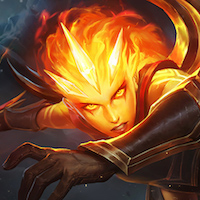Battlecast Illaoi: Visuals and Sound Effects
Jetpacks, flames, and a rather angry voice.
Now that the concept and basic modeling are close to complete, we enter a different phase of skin development. Instead of focusing on a single aspect of the skin, the team works on different parts at the same time. Today we’re looking at the progress we’ve made on Illaoi’s sound effects, visual effects, and recall animation.
Voice-Over Processing
The initial idea for the audio effects on Illaoi’s spoken lines was to put processing on all of it, creating a parallel, angry voice layer that’d phase in and out on important keywords as she spoke.
However, we need to keep in mind that we localize everything we do, which can make effects like this difficult since both the translations and delivery of the voice lines can be different across languages.
Due to the enormous number of lines Illaoi has (one of the highest in the game), and the extreme margin of error once we account for all the languages, plus the fact that she has a very complex kit (looking at you tentacles!), the original plan to create an angry Battlecast layer that phases in and out is probably out of scope. Additionally, heavily-affected VO processing would feel pretty at odds with Battlecast Illaoi’s story and visuals.
So we’ve had to drop that idea. Instead, we’re looking at doing heavy processing on her E lines (there are over 60 of these), which are the trippy, delayed ones that sound like she’s in your head.
We haven’t started working on the sound effects for her abilities yet, but hopefully next time we’ll have these built out more and will be ready to share.
Visual Effects
Generally when we make visual effects, we work on them over a number of iterations. While other disciplines can use concept art to quickly work out how something will look, VFX only exist in motion, so the usefulness of concept work can be limited. The first visual effects pass is a very rough blockout for what an effect will look like to help get a feeling for how something will look in motion.
This is an EXTREMELY EARLY test for what the passive effects on Illaoi’s robot head will look like. These effects need to capture the feeling of a “trailing element” that her base skin has while also amplifying the Battlecast aesthetic. As such, the intention for the robot head’s VFX is for it to look like there’s a spinal column trailing from it.
The second pass is where we start really refining the VFX, honing in on the elements that work and refining the colors. A final polish pass will be done later to clean up any minor visual bugs—such as the particles having a harsh edge where they intersect other geometry—or making sure things spawn and fade out smoothly.
From a VFX standpoint, Illaoi is one of the more complex champions in the game (a reoccuring theme!). A normal champion such as Nasus has around 35 individual particle files. However, between Illaoi’s tentacles, hit impacts, torn out spirits, countdown timer and dunk effects, Illaoi has over 100 individual files, all of which will need updating for her skin. Because of this, building out the skin’s VFX is going to take a little longer than usual.
Recall Animation
We generated a bunch of ideas for the recall in our initial creative meeting for Illaoi. Some of them were pretty crazy, but we decided to keep this one fairly self-contained without a ton of visual props to interact with. The community seemed to like some of the jetpack ideas from the previous post, so we thought incorporating that into the recall could be cool.
We also really wanted her to interact with the robot head since it’s such a major part of the skin. This recall seemed to be a good mix of action and fun and hits the Battlecast tone. We blocked some poses and showed it to the team. Everyone seemed to like it, so we moved forward with animating.
We thought it’d be light-hearted and still fit the Battlecast theme if Illaoi started the head up like a lawnmower to get it going.
Before the skin ships, we’ll do another polish pass to clean up the animation, and we’ll probably also add a start cord and maybe even some shoulder straps. The process thus far was done over the course of four or five days—here’s a time-lapse video showing how we animated the flying-portion of the recall:
That’s all for this week. See you next time!
Catch up on the development:
- Part One: Concepting
- Part Two: Modeling and Texturing
